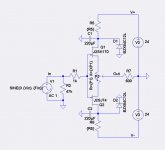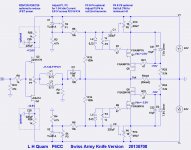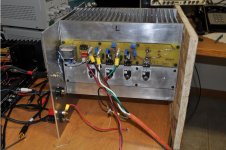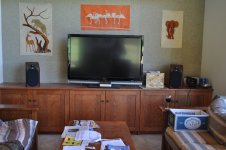My measurements were done using an M-Audio Audiophile-192 sound card. Sample-rate=192 kHz, bits/sample=24. The noise floor is better than -100dB below 1 watt. See Balanced Soundcard Interface for Power Amplifier Distortion Measurement http://www.diyaudio.com/forums/pass...ifier-distortion-measurement.html#post2753978.
The pot I was describing is 10 ohms between the source pins of the input JFETs, with the wiper connected to ground, shown below. Its purpose is to balance the operating points of the input JFETs in order to minimize H2.
I can adjust the H2 level by adjusting pots on the transformer secondary windinging with wipers connected to the output FET gate stopper. I can adjust H3&H2 with "Zen pots" across the source resisotrs of the output FETs, with wipers connected to the caps at the bottom of the secondary windings. Need a picture?
The pot I was describing is 10 ohms between the source pins of the input JFETs, with the wiper connected to ground, shown below. Its purpose is to balance the operating points of the input JFETs in order to minimize H2.
I can adjust the H2 level by adjusting pots on the transformer secondary windinging with wipers connected to the output FET gate stopper. I can adjust H3&H2 with "Zen pots" across the source resisotrs of the output FETs, with wipers connected to the caps at the bottom of the secondary windings. Need a picture?
Hi LHQUAM,
astonishing ...
My input stage was the known j74/k170 combo, xformer 1:5 and combined with a F4 outputstage, but only one pair.
Measurement was not after the input stage, but after the output stage.
The same effect, that I could manipulate K2 was possible with the BA-3 inputstage and the same F4 outputstage (no xformer, no j-FETs)
In the first case the THD was around 0.03%, a value that Nelson's M2 shows also. Turning the pot for higher k2 gave of course considerable more THD.
With the BA-3 input stage and crippled F4 and K2 minimum, the distortion values we're around 0.015%.
I think trying to make k2 higher to get the k2 sound is only recommended in this case, when you have some "headroom". With 0.015% as a starting point you cab screw up k2 around 12db over k3 and you still have only around 0.025% THD.
Why can't you mistune to higher THD or k2, real surprise!
But of course fine .....and these measurements were done with the real amp?
How do you measure distortion? Better system than sound card, I suppose....

Attachments
Last edited:
Yesterday I finished assembly of a pair of F6CC channels. So far I have only performed bench tests. I ran it overnight to verify voltage and thermal stability. Today I will start listening tests.
The chassis shown below was designed to ease the testing of experimental amplifier designs. It accepts PC boards with the Universal Mounting Specification. Output FETs can be easily switched using Molex connectors. The heatsinks are mounted fin-to-fin and can be used with convection cooling or forced-air with a pair of PC fans mounted on the bottom. I have not yet built a power supply for this chassis setup and I am temporarily using the power supply from an F5 build connected with rather long #16 wire cables. The power supply will be designed for a 10" x 12" footprint and will attach where the wooden panel is, making the overall package approximately 12" wide, 10" high, and 14" deep.
The chassis shown below was designed to ease the testing of experimental amplifier designs. It accepts PC boards with the Universal Mounting Specification. Output FETs can be easily switched using Molex connectors. The heatsinks are mounted fin-to-fin and can be used with convection cooling or forced-air with a pair of PC fans mounted on the bottom. I have not yet built a power supply for this chassis setup and I am temporarily using the power supply from an F5 build connected with rather long #16 wire cables. The power supply will be designed for a 10" x 12" footprint and will attach where the wooden panel is, making the overall package approximately 12" wide, 10" high, and 14" deep.
Attachments
No, that phone works when the power is out, and the sound quality is much better than most of the phones made today.lhquam...i love your work and the equipment but methinks you might want a new phone
Judgement Day
I finally started listening tests of the F6CC. Both channels were tuned for minimum H2 and H3 at 1 kHz, 1 Watt.
Absolutely no audible hum or noise with ear directly against the speakers. This is with an underwhelming power supply from my first F5 build with considerable rail ripple.
My initial listening tests were based on various acoustic guitar selections from Charlie Byrd, "Sketches of Spain" by Miles Davis, "Blues and the Abstract Truth" by Oliver Nelson, and others. I must qualify all of these subjective impressions on aging ears that were never the best and not getting better.
It sounds different from the balanced F5 I have been listening to for several years. My first impressions were differences in the high frequencies. I do not know if it is H2/H3 related, or related to high frequency rolloff, which I doubt. I heard something about the pluck of the string of an acoustic guitar. I need to modify my listening setup for A/B testing.
I have no doubt that different speakers, different rooms, and different ears would lead to different judgments.
I also suspect that Nelson the Magician could make tweaks to make this amplifier better.
I finally started listening tests of the F6CC. Both channels were tuned for minimum H2 and H3 at 1 kHz, 1 Watt.
Absolutely no audible hum or noise with ear directly against the speakers. This is with an underwhelming power supply from my first F5 build with considerable rail ripple.
My initial listening tests were based on various acoustic guitar selections from Charlie Byrd, "Sketches of Spain" by Miles Davis, "Blues and the Abstract Truth" by Oliver Nelson, and others. I must qualify all of these subjective impressions on aging ears that were never the best and not getting better.
It sounds different from the balanced F5 I have been listening to for several years. My first impressions were differences in the high frequencies. I do not know if it is H2/H3 related, or related to high frequency rolloff, which I doubt. I heard something about the pluck of the string of an acoustic guitar. I need to modify my listening setup for A/B testing.
I have no doubt that different speakers, different rooms, and different ears would lead to different judgments.
I also suspect that Nelson the Magician could make tweaks to make this amplifier better.
Attachments
Are you saying that you did not like the F6CC as much as balanced F5?
I haven't listened 'nuff to know.
 Being a "Swiss Army Knife" with lots of adjustments, I haven't begun to explore the possibilities.
Being a "Swiss Army Knife" with lots of adjustments, I haven't begun to explore the possibilities. BTW: It doesn't sound at all like my F6 builds. I find that speech intelligibility is fine with the F6CC, unlike my F6 builds.
Judgement Day
I finally started listening tests of the F6CC. Both channels were tuned for minimum H2 and H3 at 1 kHz, 1 Watt.
Absolutely no audible hum or noise with ear directly against the speakers. This is with an underwhelming power supply from my first F5 build with considerable rail ripple.
My initial listening tests were based on various acoustic guitar selections from Charlie Byrd, "Sketches of Spain" by Miles Davis, "Blues and the Abstract Truth" by Oliver Nelson, and others. I must qualify all of these subjective impressions on aging ears that were never the best and not getting better.
It sounds different from the balanced F5 I have been listening to for several years. My first impressions were differences in the high frequencies. I do not know if it is H2/H3 related, or related to high frequency rolloff, which I doubt. I heard something about the pluck of the string of an acoustic guitar. I need to modify my listening setup for A/B testing.
I have no doubt that different speakers, different rooms, and different ears would lead to different judgments.
I also suspect that Nelson the Magician could make tweaks to make this amplifier better.
Thanks for the first impression, everybody knows how difficult and dependent on subjective status and of course pride from the build hearing and judging can be.
My last sodom and Gomorrah was when I preferred the sound of an amp with 1% THD and only after some days of honeymoon I began to hear the distortion...
You proof as a real magician too, and the other will for sure comment your work!
My last sodom and Gomorrah was when I preferred the sound of an amp with 1% THD and only after some days of honeymoon I began to hear the distortion...
With the SITs on 0.6% going up to 5% at 15W and big SET tubes going even higher, I would be tempted not to minimize THD on my setup, but rather boost it
Last edited:
Slightly off topic, but I just slotted a very nice 2x18V 300VA R-core transformer into my F6 from here Selectronic R-Core SALE to replace a mechanically noisy toroid.
To say I am happy with the results is an understatement - all the mechanical hum that I had is completely gone. This is the quietest big mains xformer that I have come across. I also use one of their smaller units in my Pearl 2 and am very happy with that also.
It is worth bearing in mind that they do come up a bit bigger in the longest dimension than a 500VA toroid, but not much and I had no problem fitting it in a standard width chassis (like the ones in the DIY Audio store).
The reason that I mention it is that it looks like they are selling off all their stock completely. There are only 3 left of the 18V/300VA, and they are pretty keenly priced, due to the 40% off in the sale, for an R-core.
They are based in France but shipping to the rest of the EU is reasonable and very, very quick.
Ian
To say I am happy with the results is an understatement - all the mechanical hum that I had is completely gone. This is the quietest big mains xformer that I have come across. I also use one of their smaller units in my Pearl 2 and am very happy with that also.
It is worth bearing in mind that they do come up a bit bigger in the longest dimension than a 500VA toroid, but not much and I had no problem fitting it in a standard width chassis (like the ones in the DIY Audio store).
The reason that I mention it is that it looks like they are selling off all their stock completely. There are only 3 left of the 18V/300VA, and they are pretty keenly priced, due to the 40% off in the sale, for an R-core.
They are based in France but shipping to the rest of the EU is reasonable and very, very quick.
Ian
Thanks to an offline suggestion from Buzz, I reduced the compensation capacitors across the feedback resistors from 10nF to 4.7nF and the F6CC now sounds much better. The high frequency problems I noticed have largely gone away. I need to "tweak" either side of the 4.7nF cap value a little before I will be happy. I think that this amp might be a keeper. 
BTW: It doesn't sound at all like my F6 builds. I find that speech intelligibility is fine with the F6CC, unlike my F6 builds.
I'm still trying to get my head around this one....Are you saying that the F6(your F6) doesn't cut it in the speech band?
I suspect that the H2/H3 distortion is high enough to reduce the intelligibility of speech. I didn't have enough R100 fets to choose from to get a pair of low distortion channels.I'm still trying to get my head around this one....Are you saying that the F6(your F6) doesn't cut it in the speech band?
Will you have its pcb for sale?Thanks to an offline suggestion from Buzz, I reduced the compensation capacitors across the feedback resistors from 10nF to 4.7nF and the F6CC now sounds much better. The high frequency problems I noticed have largely gone away. I need to "tweak" either side of the 4.7nF cap value a little before I will be happy. I think that this amp might be a keeper.
- Home
- Amplifiers
- Pass Labs
- F6 Amplifier



